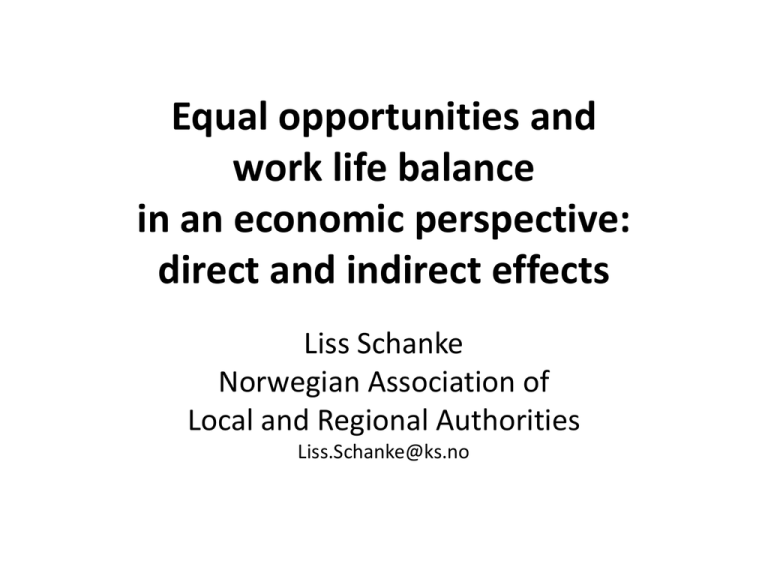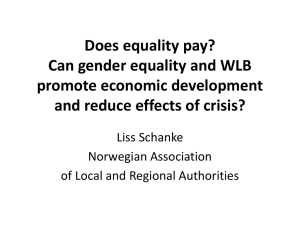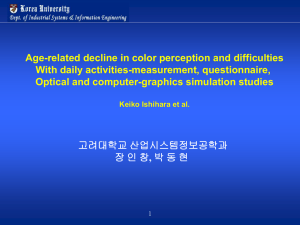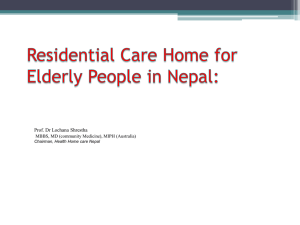Liss Schanke
advertisement

Equal opportunities and work life balance in an economic perspective: direct and indirect effects Liss Schanke Norwegian Association of Local and Regional Authorities Liss.Schanke@ks.no WORK LIFE BALANCE PROJECTS – Projects in Spain and Portugal – Very different projects: • • • • National, political and economic situations project focus and levels project partners and promoters Project activities – Broad bilateral input, municipalities, enterprises, trade unions, reseachers, NGOs – Challenges: • Bilateral cooperation and mutual learning – not easy • Simple terminology: gender? Mainstrreaming? • Focusing on specific actions and concrete results Different elements and approaches • National economic mechanisms and legislation,- e.g. regarding parental leave • Local services for children and elderly, public, private, voluntary – e.g. kindergartens • Labour policies, including working hours, pay gap, management styles, delegation, recruitment – e.g. through social dialogue • Integration of men and the male perspective – by women and men DIRECT ECONOMIC ASPECTS • Equal opportunities and work life balance can be studied and justified from many perspectives: human rights, democracy, sociology, quality • This presentation is focusing on the economic perspectives - direct economic effects and indirect economic effects Effect on birth rate and demographic balance • WLB makes it easier for couples to have children • The sustainble birth rate is 2.1. The rates in Europe vary between 1.3 and 2.2. • Low birth rates means future economic problems: few adults to support the elderly Effect on employment • WLB implies new jobs, e.g. kindergartens and institutions, public sector management • New jobs imply higher employment rate and a flexible labour market • There is a positive link between women’s employment rate and Gross National Product Effect on taxes and consumption Taxes • 2 salaries families generally earn more than 1 salary families and pay more taxes • Taxes are the basis for all public services: schools, hospitals, kindergartens, transport, institutions Consumption • 2 salaries families generally consume more, - especially if they have children • Higher consume is positive for private sector: restaurants, shops, factories, services INDIRECT ECONOMIC ASPECTS • No easy answers • Short and long term • Vary between countries and cultures • Different national context, different indirect economic effects • E.g. short and long lunch break… Better private sector company boards • Mr. A. Gabrielsen, former conservative minister for private sector, initiated the 2003 Law on 40% quota in reg.private company boards • Argument: Success of private companies depend on HR quality; they need to utilize all human resources • Ex:Women board members: 2003: 6%, 2009: 40% • Better care for the elderly • Number of persons over 80 doubled by 2035, 40.000 new employees needed • Presently 10% male employees in care for the elderly • Campaign: diversity and quality: more men in care jobs • Pilot projects: men can try a job in this sector, 8 weeks with full salary Effects of unemployment • Effects on unemployed adults and youth: motivation, capacity • Effects on children, friends, siblings • Effects of unemployment on taxes/pensions • Effects of «unregistered labour market» on business competion/quality Effects of day care • On demographic growth • On parents’ possibility for education/employment • On children’s capacity and motivation for education – especially immigrant or marginalized children • On public and private sector competence in a global competitive economy Effects of postponed retirement • Continued payment of income taxes – reduced payment of pensions • More active elderly people - happier and healthier • 2012: EU year for the active elderly • Foto jobb Effects on productivity • Does flexible working hours/place give more satisfied workers? • Does more satisfied workers give increased productivity? • Is working 08-16 more productive than 08-20? • Is presentism productive? • Best Practice: Flexibility in Bærum Effects on social capital • Many forms of capital, economic, cultural, social • Putnam: «SC is the collective value of all social networks and the inclinations that arise from these n. to do thing for each other» • More networks with 08-16.00 than 08-20? • 2011: EU voluntary year • Best Practice: Voluntary centre in Mandal Effects on male role • Work life balance may imply a new role for men in their own family • WLB may open up new jobs for men in kindergartens, institutions for elderly etc. • More men in care may imply higher total quality of care • Best Practice: REFORM and Free Choice Vest Agder GENERAL EFFECTS OF ECONOMIC EQUALITY Main message: Society benefits from greater economic equality – not only the poor – but the whole population. Examples: Life expectancy, literacy, infant mortality, homicides, imprisonment, mental illness, drug addiction, trust………….. Income differences between the richest and poorest 20% Health and Social Problems Index of: • Life expectancy • Math & Literacy • Infant mortality • Homicides • Imprisonment • Teenage births • Trust • Obesity • Mental illness – incl. drug & alcohol addiction • Social mobility Source: Wilkinson & Pickett, The Spirit Level (2009) www.equalitytrust.org.uk CONCLUDING REMARKS - Equality between women and men and work life balance that promotes demographic balance and labour participation is a basis for a sustainable economy - A sustainable economy is a basis for equality between women and men











